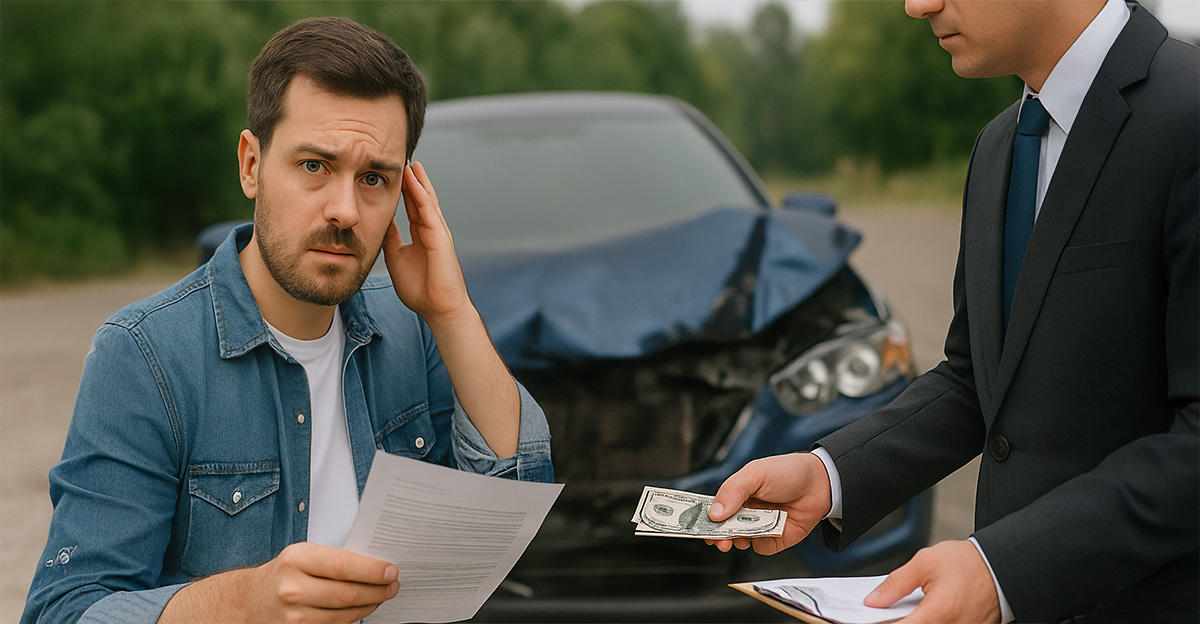You Thought You Were Doing The Right Thing, Now You Owe Thousands. What Gives?
Buying gap insurance feels like the kind of grown-up decision that deserves a gold star—like choosing a retirement plan or remembering to get your oil changed before the light starts actively pleading with you. So when your car gets totaled and you discover you still owe thousands of dollars despite having gap insurance, it can feel like someone swapped your financial safety net with a roll of wet paper towels. If you’re staring at a surprise bill and wondering what kind of scam you’ve stumbled into, you’re not alone.

What Gap Insurance Is Supposed To Do
Gap insurance is designed to cover the difference between the actual cash value of your car at the moment it’s totaled and the remaining balance on your auto loan. In theory, it’s the superhero swooping in to save you from the villainy of depreciation. If your $30,000 car is only worth $22,000 on the day of the accident, gap insurance should save you from paying the extra $8,000 out of pocket.
Why So Many Drivers Still End Up Owing Money
The trouble begins when drivers learn that gap insurance doesn’t necessarily cover every dollar associated with their auto loan. Instead, it only addresses the portion of the loan that is directly tied to the vehicle’s value. Everything else—the rolled-in charges, the dealership add-ons, the leftover balances from old cars—sits outside the protective bubble you thought you had.
 loganrickert, Wikimedia Commons
loganrickert, Wikimedia Commons
Slide Into The Most Common Scenario
The most typical scenario looks like a slow-moving financial avalanche. You buy a car with minimal money down, accept a long-term loan, allow the dealership to coil a few extra fees into the financing, and maybe even roll in the remaining balance from a trade-in that wasn’t quite paid off. Fast forward a few months, and your car depreciates faster than your patience at the DMV. Then an accident happens, and the insurer’s numbers don’t match the balance you see on your statement.
Your Loan Balance Was Higher Than You Realized
Many auto loans quietly include costs that have nothing to do with the value of the car itself. These can include dealership documentation fees, service contracts, extended warranties, wheel or tire protection plans, and sometimes leftover debt from your previous vehicle. Gap insurance typically ignores these extras completely, which means the gap between what you thought you owed and what gap insurance is willing to cover may be larger than you imagined.
Gap Doesn’t Cover Late Fees Or Missed Payments
If your loan was even slightly behind at the time of the accident, gap insurance generally won’t help with any overdue amounts. Late fees and past-due balances remain your responsibility, even if everything else is supposedly covered. It’s not the most glamorous part of the process, but it surprises a lot of drivers who assumed every dollar tied to their loan would be included.
Negative Equity Is The Silent Killer
Rolling negative equity into a new loan is like packing a suitcase with bricks and pretending it weighs the same as socks. The leftover loan balance from your old vehicle doesn’t simply disappear when you trade it in; it gets merged into the new loan, inflating your debt before you even drive away. Gap insurance usually treats this old debt as unrelated baggage, and that can leave you with a painful remaining balance when the dust settles.
Your Car Depreciated Way Faster Than Expected
Some cars depreciate faster than a dropped phone screen shatters, especially certain small sedans, fleet-heavy models, and vehicles with soft resale demand. If the market value of your car plummeted steeply right after you bought it, the actual cash value on the day of the accident may be shockingly lower than the balance of your loan. Even gap insurance can struggle to bridge a chasm that wide.
Insurance Payouts Are Based On Actual Cash Value
Your auto insurer calculates your payout based on actual cash value, which is their polite way of saying, “What your car was worth right before everything went horribly wrong.” They do not reference the price you paid, the upgrades you installed, or the emotional attachment you formed. If the insurer says your car was worth $17,000 on the day it was totaled and you still owed $25,000, that’s the number gap insurance starts from.
Gap Insurance Has Maximum Payout Limits
Many drivers don’t realize that their gap policy may have a maximum benefit that caps the amount the insurer will cover. Some policies, for example, only pay up to a certain percentage of the vehicle’s actual cash value. If your loan is far more upside-down than that cap allows, the remaining portion becomes your new, unwanted companion.
Some Dealership-Provided Gap Policies Are Surprisingly Weak
Gap sold by dealerships tends to be more expensive and less comprehensive than the version offered by traditional insurance companies. These dealer policies often come with extra exclusions, tighter limitations, and far less consumer protection. Many drivers only discover how flimsy their coverage is after the accident—not exactly the ideal moment for a surprise.
You May Have Bought “Gap Waiver,” Not True Gap Insurance
Some dealerships sell something called a gap waiver rather than actual gap insurance. A gap waiver is simply an agreement with the lender stating they may forgive your remaining balance under certain conditions. This is not the same as a regulated insurance product, and it can be packed with tiny clauses and limitations that quietly eliminate coverage when you need it most.
Your Lender May Not Be Communicating Clearly
In some cases, lenders may continue adding interest, fees, or even daily accruals while your insurance company processes the total loss claim. By the time everything is finalized, the balance may be higher than expected, and gap insurance may not cover the difference. This disconnect creates yet another opportunity for unwelcome surprises.
 Ehimetalor Unuabona becomeincognito, Wikimedia Commons
Ehimetalor Unuabona becomeincognito, Wikimedia Commons
Deductibles Can Still Apply
Some forms of gap coverage require you to pay your primary insurance deductible before gap benefits kick in. If your deductible is $500 or even $1,000, that cost still comes out of your pocket. It may not be the largest piece of the puzzle, but it adds an extra sting to a situation that already feels more painful than it should.
You May Have Cancelled Something Without Realizing It
Refinancing a car loan can unintentionally cancel your gap coverage if it was tied to the original lender or financing structure. Many drivers only discover this after a total loss occurs, when the gap company politely informs them their coverage ended months earlier.
Companies Market Gap As “Full Protection”
One of the biggest sources of frustration is the gap between how gap insurance is advertised and how it actually works. Many drivers leave the dealership believing they purchased a magic force field against financial trouble, only to learn later that gap insurance was never meant to cover everything. That misunderstanding makes the whole experience feel like a shell game.
The Real Problem: Car Financing Has Become A Trap
Gap insurance itself isn’t the villain—it’s the increasingly complicated structure of modern auto loans. Long terms, high interest rates, rolling negative equity, and unnecessary dealership add-ons turn many loans into financial traps. Gap insurance tries to plug holes in an already sinking ship, but it can only do so much.
Why It Feels Like A Scam
Even when nothing illegal is happening, the system can feel like a scam because so many parts of it are stacked against the consumer. The fine print, the confusing loan structures, the rapid depreciation, and the overly cheerful dealership pitches all create a sense that you were never meant to come out on top.
What To Do If You Still Owe Thousands
If you’re dealing with a leftover balance despite having gap insurance, your best first step is to request a full, itemized explanation from both your insurer and your lender. Once you understand how each number was calculated, you can look for potential errors, unexpected fees, or misapplied credits. You may also be able to negotiate payment plans, ask the lender for goodwill reductions, or request prorated refunds on cancelled warranties or service contracts.
Ask Your Insurer To Review Their Valuation
Insurers determine vehicle values using market software that isn’t always perfect. If you find comparable vehicles selling for more in your area, you may be able to challenge the valuation and secure a higher payout. Even a few hundred extra dollars can make a noticeable difference in your remaining balance.
Check Whether Add-Ons Can Be Refunded
Some of the products included in your original loan, such as extended warranties or appearance protection plans, can be refunded after a total loss. These refunds are often prorated, meaning you only get credit for the unused portion, but the amount can still help reduce what you owe.
How To Avoid This Nightmare Next Time
Future car purchases can be made much safer by making a reasonable down payment, avoiding the temptation of rolling old debt into a new loan, skipping unnecessary dealership packages, and keeping loan terms shorter. Buying gap insurance through your insurer instead of the dealership also provides stronger protection in most cases. And selecting cars with strong resale value keeps depreciation from turning into your worst enemy.
When Gap Insurance Really Does Save People
Despite its limitations, gap insurance is incredibly valuable in many situations. Drivers with small down payments, long-term loans, or fast-depreciating vehicles often avoid devastating financial losses because gap insurance steps in when they need it most. When paired with a healthy loan structure, gap does exactly what it’s supposed to do.
Consider New Car Replacement Policies
Some insurers offer new car replacement coverage, which pays for a brand-new version of your vehicle rather than the depreciated value. Combining this type of coverage with gap insurance can dramatically reduce the risk of ending up with a balance you can’t afford to pay.
The Question Everyone Asks: Is Gap Insurance Worth It?
Gap insurance is worth it for drivers whose financial or vehicle situation puts them at risk of owing more than the car is worth. For those with larger down payments, shorter loans, or slower-depreciating vehicles, it may not be necessary. Whether it’s worthwhile depends entirely on your personal financial structure.
The Real Scam: Complexity, Not Con Artists
Most people who feel scammed were not deceived by criminals; they were blindsided by the sheer complexity of modern auto financing. Gap insurance operates within a technical, tangled financial ecosystem that makes it extremely difficult for the average person to know exactly what they’ve bought.
The Bottom Line
If you purchased gap insurance and still owe thousands, you probably weren’t scammed—but you were pulled into a system that makes it nearly impossible to understand what’s truly covered. The solution isn’t to avoid gap insurance altogether but to demand clearer loan disclosures, choose more transparent financing options, and ask better questions before signing anything. With the right knowledge, you can protect yourself from both surprise debt and surprise disappointments the next time you buy a car.
You May Also Like:
If You Were A 70s Teen, These Cars Definitely Appeared In Your Dreams
Toyota's 2026 RAV4 Shows Off A Fresh Design Inside And Out































